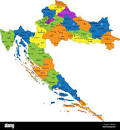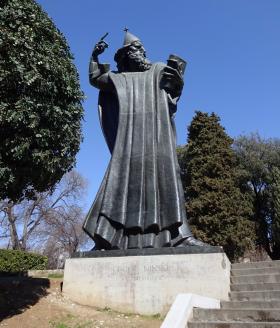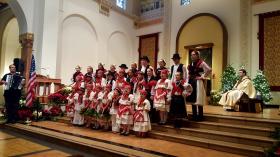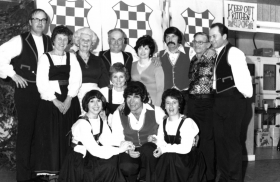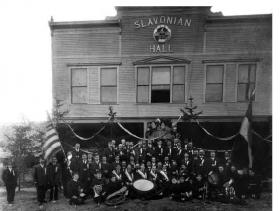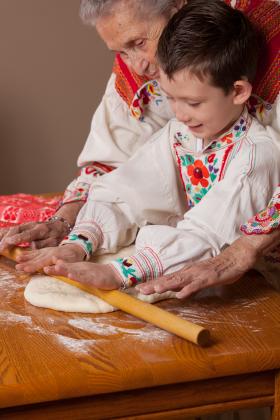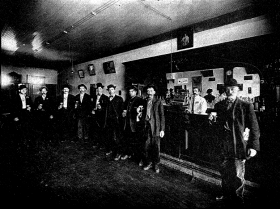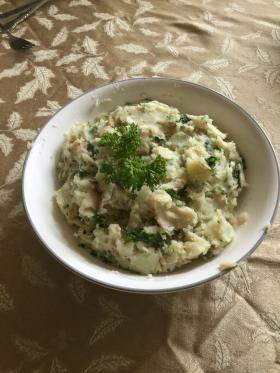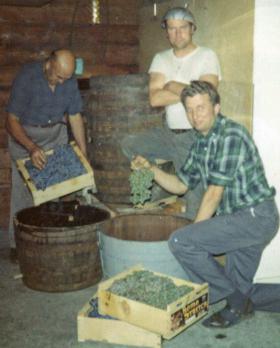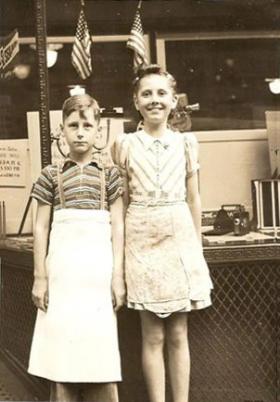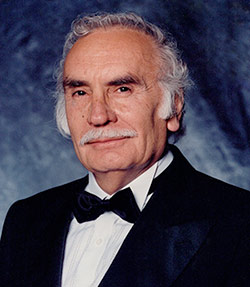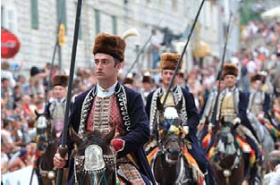WHAT CAN CROATIA DO FOR YOU
WHAT CROATIA HAS TO OFFER
Croatia welcomes thousands of tourists from around the world. The country also provides several programs to attract Croatian descendants to learn about its rich history, language, business opportunities and more.
DOMOVINA BIRTHRIGHT PROGRAM
The Domovina Birthright Program is an unforgettable experience for young adults of Croatian descent between the ages of 18 – 30 who want to ...
20 Years of CroatiaFest
It all began with idea inspired by a group of Northwest Croatian American Community leaders and has become one of the premier festivals in the series of Festal ethnic festivals at the Seattle Center. In 2004, the footprint was designed and established by CroatiaFest’s first coordinator Alma Plancich, who set the standard of excellence and first-class programing. From that blueprint, we have been able to expand the festival to the extent that we are “bursting at the seams”.
CroatiaFest is a one-of-a-kind Croatian festival in the United States as it is free and open to the public. In the past 20 years CroatiaFest has showcased the Croatian heritage and ...
Trg Kralja Tomislava, Zagreb, Croatia
After the reign of Croatian King Tomislav, who ruled from 910 as Duke and from 925 to 928 as King, Croatia would not be a sovereign nation until the advent of President Franjo Tudjman in 1992. During his reign, Kralj Tomislav united the Croats of Dalmatia and the Slavs of Pannonia into a single Kingdom.
Croatia notably had its own Parliament (Sabor) from 1273. While under subjugation of the centuries-long Hapsburg empire, which collapsed in 1918, Croatia enjoyed a degree of autonomy and had its own official language. During this era, Croatia was placed under Hungarian jurisdiction. For over a millennium, Croatia remained under the sovereignty of foreign powers. But many Croats continued to seek full autonomy.
The equestrian statue of Croatia’s first king, by the ...
FAMOUS CROATIAN STATUES
Split: Grgur Ninski Statue, 1929
The Grgur Ninski, “Gregory of Nin,” statue was sculpted in 1929 by Ivan Meštrović (1883 to 1962). At an impressive height of 28 feet, the statue is located at the north gate of Diocletian’s Palace in Split. Before entering the palace, it is traditional to rub the statue’s toe for good luck.
University of Notre Dame:
The career of Meštrović, commonly referred to as “the Maestro,” is inextricably linked to the University of Notre Dame and the Snite Museum of Art. Meštrović was brought to campus in 1955 by Father Theodore M. Hesburgh, the legendary 15th-president of the university. Until his death in January of 1962 Meštrović served as “sculptor in residence” at Notre Dame, where he created a wide array of work now found across the campus and in the museum.
While in Chicago in 1925 for an exhibition at the Art Institute of Chicago, Meštrović was commissioned to create two monumental mounted American Indians at the Michigan Avenue entrance of Grant Park.
Dubrovnik: ...
HRVATSKI JEZIK , CROATIAN LANGUAGE Who Are The People In Your Family
Today in the age of testing one’s DNA to find out one’s ethnic background and finding lost relatives, many Croatian Americans too, are constructing their family trees. In researching old documents and trying to decipher often times difficult to read penmanship, folks are encountering Croatian words that do not have English equivalents. Specifically, in the case of family names unique to the Croatian language. This year at CroatiaFest we will have a panel with all of the possible family names you may encounter in your research.
Names of immediate family members are pretty straight forward. Father is otac and mother is majka or mati; brother is brat and sister is sestra. Diminutive names for these family members include ...
KRALUS
It began as many great things do….with an idea in Johnny Morovich’s head. As Artistic Director of the Seattle Junior Tamburitzans (“SJT”), years ago Johnny had acquired five original 100+ year old costumes from Sveta Nedelja, northwestern Croatia.They were purchased from a woman who had originally bought them at the Dolac Market in Zagreb back in the 1970s.
This was the year he was going to teach SJT’s intermediate dancers a set of dances from Sveta Nedelja and be able to showcase these beautiful costumes. “There’s a necklace that goes with this costume,” he told me. Since I have had a creative beading habit for quite some time, I told him I would look into it. I googled “Sveta Nedelja necklace.” What I found would astound me.
Discovering the Kraluš
The Kraluš was so beautifully intricate…there was no way I would be able to visually figure it out on my own. After a deep dive into Pinterest, I came across some YouTube videos and a link to an online Kraluš course ...
CROATIAN TRADITIONS By Cathryn (Mirkovich) Morovich
Many of our centuries old Croatian traditions are based on our Roman Catholic faith. Fast and abstinence played a large role in the Croatian holiday menus. Catholics abstained from meat on Christmas Eve. During the cold winter months with bad weather, the fishermen of Croatia could not take their small boats out to sea, so fishing was primarily done during the warm spring and summer months of the year. Before modern day preservation methods, fish was salt cured and dried in the hot sun. Bakalar, salted dried cod, was ...
AMERICAN CROATIAN CLUB OF ANACORTES CELEBRATING 45TH ANNIVERSARY
The club was founded in 1972. “It was decided that the goals of our new organization were the preservation and promotion of Croatian culture, customs, and heritage” adopted at an informal meeting held to form an association of Croatians which was to become the American Croatian Club of Anacortes. The estimated adult Croatian population in Anacortes in 1971 was 187. Nikola Mavar Sr and Vlatko Kolega were selected as president and vice president, respectively; both had been involved in the early years of San Pedro’s Croatian club and were inspired by the “Croatian Spring” events in their homeland.
When the fishermen returned that fall, planning commenced ...
The Early Croatians of Old Tacoma in Pierce County
According to a 1984 report produced by the Washington State Historical Society and written by Mary Ann Petrich and Barbara Roje, many of the early Croatians came from the Dalmatian coastline of the Adriatic Sea. The people who came to Old Tacoma in Pierce County emigrated predominantly the islands of Hvar, Vis, Korcula, Brac, and Solta. They were seafaring people who had left their homeland because of economic and personal problems brought on by pressures from the Hapsburg regime. Having heard from others many set their sights on making Washington and the Puget Sound their destination as it was known to resemble their Adriatic homeland.
One of the early immigrants, Jelica Mullan, recalled later in life of her arrival in Old Town Tacoma on December 25, ...
Traditions
Traditions are those actions that we habitually perform. Traditions are those things we learn from our elders by handing down of age old stories, customs, information, history, songs, food preparation, or hand crafts we learn from our elders.
Traditions can be as simple as baking a cookie from a tattered hand-written recipe, planting wheat berries at Christmastime or they can be as grand as spit roasting a whole lamb on a special occasion.
After four generations of Croatian Americans born here in the Puget Sound Region, many traditions have been maintained, but unfortunately many have been forever lost in their original context.
This can be partially attributed to overwhelming wish to assimilate in to American life, and due to the lack of critical mass in order to perform some of the traditions. For those reasons, most what exists, with some exceptions, survives in individual homes.
One of the main goals of CroatiaFest is to bring to light and preserve many of those traditions with the hope that attendees can take away the inspiration to renew a family tradition or start a new one.
Since Croatia’s entrance to the European Union, several traditions have been nominated and added to the UNESCO Representative List of the Intangible Cultural Heritage of Humanity. Some of those traditions are still maintained in the Pacific Northwest, others are very obscure. At CroatiaFest 2014 attendees will be able to see and hear some of these traditions performed and you’ll be able to learn more about these traditions with lectures, demonstrations, multi-media presentations and workshops ...
Passed On Croatian Traditions
Many Croatian traditions have been passed from one generation to the next, perpetuating our beautiful and colorful heritage. The art of wine making and “rakja” (white lighting whiskey), hand work such as knitting, crocheting and embroidery, music played on the tambura, accordion or guitar and of course the many, many verses to folk songs which vary from region to region and village to village. Hearty main dishes of meat and fish stews, soups, BBQ lamb and pork, and of course the delicious old fashion cabbage rolls called Sarma, were a staple on a Croatian dining table.
One of the most endearing of ...
Coffee-Break Treats From The Old Days
Several years ago , this article was printed in the Seattle Post Intelligencer. The P-I invited readers to send their favorite recipes passed down from their grandmothers. This story by Elaine Montgomery Matheson (nee Kaloper) was chosen from numerous responses.
Coffee-Break Treats From The Old Days
We called my grandmother Baba Matusha (Grandma Matilda B. Kaloper) and was she a great homemaker and cook!
Every day as 2 pm rolled around, preparations for coffee break would begin….the best part of the day. The coffee was made by Dida (my grandfather) in a hand strainer over a coffee pot. Then we would hear the click, click of ...
Augie's Tavern, Cle Elum
In the days of King Coal, the one thing that there was no scarcity of in Cle Elum was saloons and taverns. One establishment that marked itself from the others was "Augie’s Tavern".
Augie’s was located in the East 200 block of town in the Schober Building, an edifice a cut above the rest. Andrew Petrich purchased the tavern in 1930 and his son Augie took over the business in 1938. Augie continued the business until his death in 1973. His wife, Mary took over for a short time after Augie’s passing.
Augie’s was more than a place where the local Croats came in to quench their thirst. It was a place to meet, to discuss the events of the day or times: how many coal cars your crew loaded, what was happening in the “old country”, a ...
The "Bakalar" Notebook
Grandma Mary could cook. She could take anything in the kitchen and whip it into a great meal. A little bit of this and a little bit of that (she never measured anything) and we would have a delicious meal. Vegetables came from the garden, vino came from Grandpa Nick’s dirt floored wine cellar (there’s another story), chicken came from the coup (not the grocery store), and she made her own bread. But bakalar was a mystery to us grandkids. We knew it was a fish dish, it was for special occasions, and we rarely saw Grandma Mary make it. We loved the fish and potato mixture, oozing with olive oil and garlic with a hint of black pepper.
In 1985 my cousin, Jeff, and I decided we had better witness the making of this mystery. So we sat down in “Gramma’s” kitchen one day, paper and pen in hand, along with a few pivos. The first page of the Bakalar Notebook had begun. We took copious notes.
Gramma had all the ingredients gathered on the kitchen counter: dried salt cod, russet potatoes, olive oil, garlic and black pepper. She started by soaking the cod in cold water for 3 hours. During the preparation, she recalled how, long ago, the salt cod could only be had in dried, salted slabs of the fish. The soaking took many more hours, if not days, to reconstitute the fish. Now the salt cod is nicely de-boned, filleted, and salted, sold in wooden boxes from Nova Scotia at $13.00 a ...
Remembering Basement Food
If you are old enough to remember the Second World War, and your parents were immigrants from Croatia, chances are the basement of your home played a very important part of your daily lives. Besides the obvious – wine making – the basement was a hub of many other cooking and eating activities for the family.
I grew up in a typical Croatian community in Ruston (Tacoma), close to the Asarco Smelter where my father and many other Croatian men worked. Within a square mile there were five Croatian “Ma & Pa” grocery stores where the families all lived in the same building as the store. In the 1920’s the immigrants of Ruston built a Croatian Hall called the Ruston Slavonian Hall, and for decades, all of the fun Croatian activities took place there, meetings, dinners, dances, etc.
To get back to basement food – to a Croatian immigrant, a basement was very important and if a house didn’t have one, quite often they dug one! That is exactly what my Father did and in 1945 he dug under our house until he found a rather big obstacle – a huge six-foot granite rock right in the middle of the basement. This then became not only my father’s problem, but a Croatian neighborhood problem with all of his Dalmatian buddies giving him advice on how to get rid of the rock. After three ...
Lowman Lunch
The Lowman Lunch was nestled on the first floor of the Lowman Building located between 1st and 2nd Avenues on Cherry Street in Seattle's Pioneer Square. Anthony Morovich bought the little 10 stole counter type café in 1933. Because of its location, he had an eclectic group of customers. Lawyers and judges working at the King County Court House, businessmen with offices in the Lowman Building along with their secretaries and stenographers frequented the little restaurant as well as the regular foot traffic customers.
“Ray” as he was known to his customers, was born Ante Antonja-Morović April 25, 1895 on the Island of Zlarin, near the City of Šibenik. He accompanied his father Pere Antonja (after the death of his mother and infant brother in childbirth) to Algiers with a group of Zlarinjani who worked on the Suez Canal, there he got his primary education in French language schools.
As many as 50 of the Zlarin Suez Canal workers then came to Seattle to build the Montlake Cut --- Ray and his father being a part of that group. He joined the United States Army in 1917 and was assigned to the kitchens where he received his training as a cook. For many years after the service, he cooked on Croatian commercial fishing boats and for some unknown reason was nicknamed “Riser”.
Returning to Zlarin in 1931, he married Ane (nee) Branica . Ane and their six month old baby girl, Jenny, immigrated to the United States and the couple settled in the Riverside community of West Seattle. Their son, John was born in ...
Did You Know?
Okay, by now most readers know that among his hundreds of patents Nikola Tesla fathered the distribution of alternating current and the polyphase electric motor-- inventions that power industry and provide the basis for our modern way of life. But DID YOU KNOW that Tesla, born in 1856 in Smiljan, Croatia to Serbian Orthodox parents, was also the father of radio? Although most textbooks still credit the Italian scientist Marconi as the inventor of radio, the U.S. Supreme Court in 1943 ruled that Tesla's patent preceded that of Marconi.
And DID YOU KNOW that Ivan Lucic (later Lucas) was a pioneer in the U.S. oil industry. Lucic, born in Split, Dalmatia in 1855 was an electrical engineer but, unlike his contemporary Nikola Tesla, he used his skills to pursue oil-- "black ...
Hrustule - a Croatian Christmas tradition
Of course we had a tree with lights, hung our stockings on the fireplace and sang Christmas carols when I was a kid. But we really knew that it was Christmas when my grandfather made hrustule. When the cardboard boxes lined with foil and heaped full of these delicate, powdered sugar coated treats came out it had to be a special occasion.
A hrustule is a thin, elongated, fried cookie that, when correctly made, is crispy and delicate and will literally dissolve in your mouth when you eat it. Because of the time involved, hrustule are traditionally prepared only for important occasions. In our family they were only made at Christmas and sometimes for weddings.
Many other cultures also have a tradition of fried holiday cookies, distinguished by their unique flavorings. For example Norwegian fattigmand are very similar to Croatian hrustele, but are flavored with cardamom and lemon. Hrustule have their own unique set of flavorings. In our family, they always contained vanilla, whiskey, and a healthy dose of anise. ...
The Tony Maglica Story
Tony Maglica was born in New York City in November 1930, about a year into the Great Depression, and was baptized at the old Church of Saints Cyril and Methodius on West 50th Street in Manhattan. His parents, Jerko and Tomica Maglica (nee Jurcan), had emigrated from Croatia some years earlier. His father worked as a longshoreman when there was work to be found, while his mother kept the home.
As the Great Depression deepened and the family’s financial circumstances worsened, it was decided that Tony and his mother would return to her native village on the Croatian island of Zlarin, where living would be cheaper and they could live with her extended family. His father would remain in America, working when he could, sending money when he could, with the goal of eventually bringing the family back together in America.
In September 1932, when Tony was 22 months old, he and his mother departed New York by sea, bound for Croatia. Although neither Tony nor his mother could have known it then, Tony was not to set foot on American soil again for eighteen years.
Arriving on Zlarin, ...
Famous Pioneer of Silicon Valley: Victor Grinich
What comes to your mind when you hear the words “Silicon Valley”? Most people know that this is where the computer industry began in California over 50 years ago and is still the center of the hi-tec world. But, how many people know that a Croatian American from Aberdeen, Washington was one of the founders of Silicon Valley?
Victor Grinich was a pioneer in the semiconductor industry and a member of the “Traitorous Eight” that founded Silicon Valley. The son of Croatian immigrants, he was born as Victor Grgurinovich 1924, in Aberdeen. His father, Nicholas, was from Desne, Croatia and after immigrating to America, he settled in Aberdeen and became a member of the Aberdeen Croatian Fraternal Union Lodge 271. (Desne, near present day Ploce, is also the birthplace of another famous Croatian, Mike Grgich of Grgich Hills Winery in California.) Victor served in the US Navy during World War II. To make his last name easier to pronounce during military roll calls, he officially changed it to “Grinich”.
Victor Grinich received a Bachelor’s degree from the University of Washington in 1945 and a Master’s Degree in 1950, and then earned a Ph.D. in 1953 from Stanford University. He worked at the seminal Shockley ...
UNESCO
United Nations Educational Scientific & Cultural Organization (UNESCO) annually publishes a list of intangible cultural heritage of humanity and in need of urgent safeguarding. Croatian culture and traditions such as Klapa singing, Nijemo Kolo ( silent dancing), the Licitar Heart, and the art of bobbin lace making have been recognized by this organization. For the past several years, CroatiaFest has showcased many of these traditions.
Listed below are some traditions that you may or may not be familiar with which are yearly celebrations held in Croatia to this day.
SINJSKA ALKA
Sinjska Alka The Sinjska Alka is a chivalric tournament that takes place annually, as it has ...
CroatiaFest Sponsors













